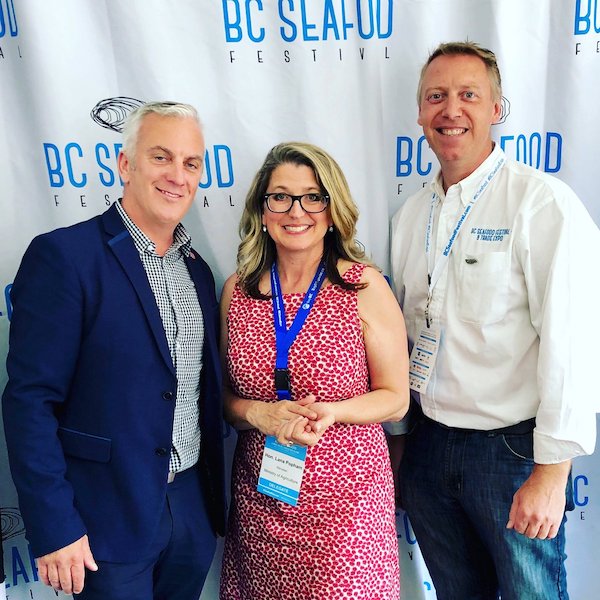Demand for B.C. seafood growing globally
BC Seafood Expo and Festival 2019 closes with a growing global appetite for more farmed and wild Canadian seafood.
By Fabian Dawson
SeaWestNews
If there was one take away from this year’s edition of the BC Seafood Expo and Festival, it is “give us some more”.
International buyers, trade commissioners and representatives, local harvesters and fish farmers all said that the demand for B.C. seafood is skyrocketing.
“We had the largest international buyers’ delegation in the history of the event and dozens of deals have been set in motion…but what we hear the most, is give us some more,” said John Watson, executive director of the Comox Valley Economic Development, the organization that collaborates with a wide range of seafood organizations and institutions to develop the expo and festival annually.
The events in the Comox Valley on Vancouver Island concluded last weekend.
Nguyen Van Binh from Ha Long Canfoco said Canadian seafood, particularly B.C. salmon and oysters, are premium products in Vietnam and much sought after.
“We are hoping to get a secure and steady supply…people love it,” he told SeaWestNews.
“This is a good place to grow fish and seafood,” said Vladimir Genis of Ukraine’s Flagman Seafood.
“We already buy a lot of hake but we are looking for new products for the European market because of the demand,” said Genis.
Ed Sang of Pacific Rim Shellfish whose market includes China, Vietnam, Singapore, Hong Kong, Taiwan, USA and the European Union countries, works directly with fishers and farmers to source his products.
“The demand in China has slowed a little bit but it has been more than made up for by growing demand in South Korea and Vietnam,” said Sang, who distributes about $30million of Canadian seafood products every year.
Clare Li, sustainability director of Gindara Sablefish, which operates the only commercial scale ocean-pen sablefish farm in the world on the West Coast of Vancouver Island said current production of two million pounds a year is increasing by about 15 per cent annually.
In Japan, the Gindara Sablefish or Black Cod is prized as a true sashimi fish that can be served raw, without freezing
“More and more Canadians are also coming to love it and yes definitely there has been lots of interest from people everywhere in the world,” said Li.
Darlene Winterburn, executive director B.C. Shellfish Growers Association, said there is not enough product to go around.
“We cannot meet the demand that’s out there…it’s an amazing product that is loved in Canada, the US, Europe and in Asia…with Asia being a constantly growing market
“We are working towards different ideas to increase production particularly in our oysters.” She said.
B.C.’s farmed oyster harvest totalled 7,700 tonnes in 2017 and accounted for more than one-third of the provincial shellfish harvest. Oyster sales in B.C. generated $29 million in wholesale value in 2017 and represented about half of the shellfish aquaculture industry’s value.
In early June, more than 100 oyster farmers from British Columbia’s coastal communities got grants of up $10,000 from the B.C. Oyster Recovery Fund to restock their beds with oyster seed.
“Living in B.C. means proximity to the ocean, delicious fresh shellfish, and a whole range of innovative and amazing chefs and recipes,” said Lana Popham, Minister of Agriculture.
“A visit to the B.C. Seafood Festival is a fun and tasty way to connect with sustainably produced and harvested food from our waters, and discover more ideas and motivation to #BuyBC shellfish and seafood year-round.”
“Markets in Asia are showing huge potential for BC salmon with year-over-year growth more than doubling in many markets,” said John Paul Fraser, the executive director of the BC Salmon Farmers Association.
He said farm-raised salmon is B.C.’s highest valued seafood product, the province’s top agricultural export, and generates over $1.5-billion towards the B.C. economy, resulting in over 6,600 jobs.
The Pacific Urchin Harvesters Association, The Pacific Sea Cucumbers Harvesters Association and seaweed farmers, showcasing their products at the expo also reported increased demand for their products globally.
British Columbia’s seafood sector produces more than 100 different species of wild and farmed fish, shellfish and marine plants, which are shipped to markets across Asia, Europe and North America. In 2017, B.C. exported $1.3 billion in seafood products to 73 markets.
The top five seafood export markets were United States at $777 million (60 per cent); China $257 million (20 per cent); Japan $111 million (nine per cent); Hong Kong $33 million (three percent); and Ukraine $19 million (two per cent).
The fastest growing export markets of the top 10 markets were Macao (130 per cent), Hong Kong (41 per cent) and Japan (4 per cent).
The top five seafood exports from B.C. were $512 million in farmed Atlantic salmon; $131 million in crabs; $72 million in hake; $57 million in geoduck clams; and $55 million in herring.
At the BC Seafood Expo: (Image l to r) – James Howey, Air Canada’s manager of Business Development, Lana Popham, Minister of Agriculture and John Watson, executive director of the Comox Valley Economic Development
RELATED NEWS
B.C. is a hotbed of innovation in aquaculture

